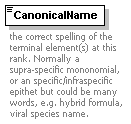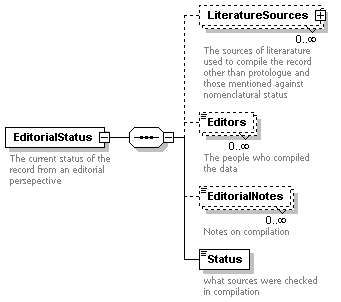
| documentation | Container for all elements of a name record |
| schema location: | F:\Data\sharedocs\linnaeancore.xsd |
| Elements | Complex types |
| NameRecord | NameParentType |
| NameRecordType | |
| SimpleBiostatusType | |
| SimpleCitationType | |
| VernacularNameType |
| diagram |  |
||
| annotation |
|
| diagram |  |
| diagram |
| diagram |
| diagram |  |
| diagram |  |
| diagram |  |
||
| annotation |
|
| diagram |  |
||
| annotation |
|
| diagram |  |
||
| annotation |
|
| diagram |  |
||
| annotation |
|
| diagram |  |
||
| annotation |
|
| diagram |  |
||
| annotation |
|
| diagram |  |
||
| annotation |
|
| diagram |
| diagram |
| diagram |
| diagram |
| diagram |
| diagram |
| diagram |
| diagram |
| diagram |
| diagram |
| diagram |
| diagram |
| diagram |
| diagram |
| diagram |
| diagram |
| diagram |
| diagram |
| diagram |
| diagram |
| diagram |
| diagram |
| diagram |
| diagram |
| diagram |
| diagram |
| diagram |
| diagram |
| diagram |
| diagram |
| diagram |
| diagram |
| diagram |
| diagram |
| diagram |
| diagram |
| diagram |
| diagram |
| diagram |
| diagram |
| diagram |
| diagram |
| diagram |  |
||
| annotation |
|
| diagram |
| diagram |
| diagram |
| diagram |
| diagram |
| diagram |  |
||
| annotation |
|
| diagram |  |
||
| annotation |
|
| diagram |  |
||
| annotation |
|
| diagram |  |
||
| annotation |
|
| diagram |  |
||
| annotation |
|
| diagram |  |
||
| annotation |
|
| diagram |  |
||
| annotation |
|
| diagram |  |
||
| annotation |
|
| diagram | |||
| annotation |
|
| diagram |  |
||
| annotation |
|
| diagram |
| diagram |  |
||
| annotation |
|
| diagram |
| diagram | |||
| annotation |
|
| diagram |
| diagram |  |
| diagram |  |
||
| annotation |
|
| diagram |  |
||
| annotation |
|
| diagram | |||
| annotation |
|
| diagram |  |
||
| annotation |
|
| diagram |  |
||
| annotation |
|
| diagram |  |
||
| annotation |
|
| diagram |  |
||
| annotation |
|
| diagram |
| diagram |
| diagram |  |
||
| annotation |
|
| diagram | |||
| annotation |
|
| diagram |  |
||
| annotation |
|
| diagram |  |
||
| annotation |
|
| diagram |  |
||
| annotation |
|
| diagram |  |
||
| annotation |
|
| diagram | |||
| annotation |
|
| diagram |  |
||
| annotation |
|
| diagram |  |
||
| annotation |
|
| diagram |  |
||
| annotation |
|
| diagram |  |
||
| annotation |
|
| diagram |  |
||
| annotation |
|
| diagram |  |
||
| annotation |
|
| diagram |  |
||
| annotation |
|
| diagram |  |
||
| annotation |
|
| diagram |
| diagram |  |
||
| annotation |
|
| diagram |
| diagram |  |
||
| annotation |
|
| diagram |  |
||
| annotation |
|
| diagram |  |
| diagram |
| diagram |
| diagram |  |
||
| annotation |
|
| diagram |  |
||
| annotation |
|
| diagram |  |
||
| annotation |
|
| diagram |
| diagram |  |
||
| annotation |
|
| diagram |  |
||
| annotation |
|
| diagram |
| diagram |
| diagram |  |
||
| annotation |
|
| diagram |
| diagram |
| diagram |  |
| diagram |  |
||
| annotation |
|
| diagram |
| diagram |
| diagram |
| diagram |
| diagram |  |
||
| annotation |
|
| diagram |  |
| diagram | |||
| annotation |
|
| diagram |  |
| diagram |
| diagram |  |
||
| annotation |
|
| diagram |  |
||
| annotation |
|
| diagram |  |
||
| annotation |
|
| diagram |
| diagram |
| diagram |
| diagram | |||
| annotation |
|
| diagram |  |
||
| annotation |
|
| diagram |
| diagram |
| diagram |  |
||
| annotation |
|
| diagram | |||
| annotation |
|
| diagram |  |
||
| annotation |
|
| diagram |
| diagram |
| diagram |
| diagram |
| diagram | |||
| annotation |
|
| diagram |
| diagram |
| diagram |
| diagram |  |
||
| annotation |
|
| diagram |
| diagram |
| diagram |
| diagram |
| diagram |
| diagram |
| diagram |
| diagram |
| diagram |
| diagram |
| diagram |
| diagram |
| diagram |
| diagram |  |
| diagram |
| diagram | |||
| annotation |
|
| diagram |
| diagram | |||
| annotation |
|
| diagram |  |
||
| annotation |
|
| diagram | |||
| annotation |
|
| diagram |  |
||
| annotation |
|
| diagram |
| diagram |